To kick off HR Policy’s Annual CHRO Summit, a panel of CHROs and AI experts discussed the implications of increased integration of artificial intelligence into the workplace, particularly within HR functions. Moderator Susan Podlogar, CHRO of MetLife, set the foundation for the panel, noting that AI is a change accelerator and CHROs need to ask whether they and their workforces are prepared for the impact of the change. Top considerations for CHROs should be whether the organization is healthy, the culture is strong, and if the application of AI will be fair and equitable.
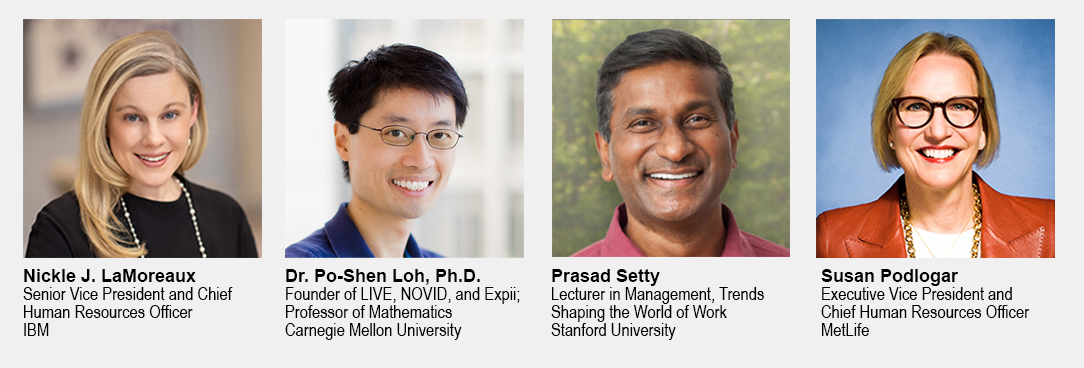
“The defining technology of this century.” Panelists discussed the enormous promise presented by AI for the workplace and workforce, and how the technology is here to stay, whether companies are ready for it or not. “The question isn’t what can I do now that I wasn’t able to do in the past – the better question is what will AI replace?” said Prasad Setty. Nickle LaMoreaux of IBM added that companies should think of AI not as a technology but as a platform that is changing the way work gets done. “Workforce planning will never be the same,” said Ms. LaMoreaux.
“Curiosity is King,” suggested Dr. Po-Shen Loh. In linking future workforce success to flexible and agile employees who can solve for new problems, Dr. Loh encouraged HR teams to scout for what’s next and hire for curiosity. If AI can handle the more mechanical tasks, for example video production, it frees up employees to think about what kind of video should be produced. This view was shared by Mr. Setty, who noted that AI can free employees from the amount of shallow work that consumes the day. “We do not have enough time to do deep work. We have so many emails to answer, we don’t get to the real stuff.” Ms. LaMoreaux emphasized this point in relation to workforce development, “AI will take away transactional work, so we need to skill people for higher value work.”
The panelists offered several key considerations for integration of AI into HR and the workplace, including:
- Ensuring that key decision-making still lies in human hands (“a human in the loop”), and that there are checks and balances in both directions between AI and humans.
- Companies are still defined by their people – AI is the platform, but companies should use the platform to augment their people, not replace them.
- Companies should consider how they can use AI to democratize access to skills, training, and benefits that were previously difficult to provide to the whole workforce (e.g., executive coaching through Gen AI).
- Understanding your business partner and legal team appetites for risk is essential.
“The biggest risk is inaction.” Each panelist emphasized the importance of acting now not only to integrate these new technologies, but to build out frameworks and guardrails to ensure their responsible and effective use. This responsibility largely lies with the CHRO, “The CHRO role is really the only one who can implement AI in your organizations in the way you need to,” noted Ms. LaMoreaux.
Concurrent Session 1: How Should AI Be Structured Within Companies for Maximum Effect?
By Margaret Faso
Ann Addison of Northrop Grumman led a discussion with Georgeann Couchara of Danaher on how companies are establishing their AI governance frameworks.
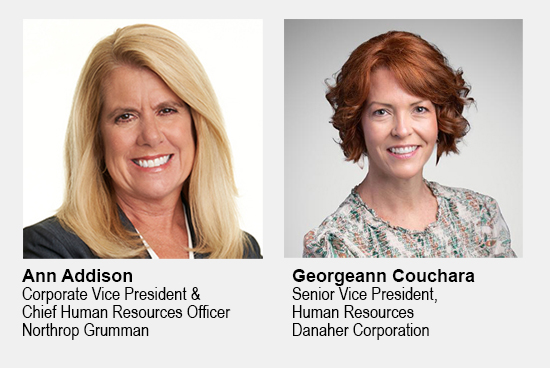
“HR has never been so exciting.” Ms. Addison opened the concurrent session reflecting on the potential for AI to improve productivity and innovation while helping to fill gaps caused by the shortage of skilled workers. She stressed the important role of CHROs in maintaining the human side of the technology, noting that companies should view AI as a tool to reach broader strategic goals rather than something to fear and suppress.
Restructuring HR to be compatible with AI. Ms. Couchara discussed how the current structure of their HR teams are not very compatible with AI. To fully integrate AI into the business, as well as within HR teams, Danaher continues to undergo restructuring so that AI can be used not only to improve productivity and efficiency for their customers but also for their internal teams.
Setting up governance structure. Both Ms. Addison and Ms. Couchara discussed how their companies are approaching setting up governance processes around AI. Frequent meetings with teams comprised of legal, IT, and HR allow leadership to gain a better understanding of the capabilities of AI and allow for regular feedback from team members regarding their experiences using the technology. Both companies utilize private, internal systems as they navigate the security of this technology and have created roles for someone to lead this integration whether through a Chief Scientific Officer or Chief Information Officer. Danaher is adding a new role, Chief AI Officer, that will initially report directly to the CEO.
Crucial that data teams understand HR. In order to use AI to its full potential in HR, it is important that technology or science teams work closely with HR so they understand what HR teams need. Many companies have an AI team within HR. This person often serves as a liaison to IT, but without some kind of integration, many AI programs will not be built in a way that is useful to the function.
Concurrent Session 2: Good AI Governance, Ethics, and Legal Compliance
By Gregory Hoff
Michael Fraccaro of Mastercard was joined by the Hon. Keith Sonderling, EEOC Commissioner and Oliver Patel of AstraZeneca for a discussion on the regulatory frameworks and legislation being developed in response to growing uses of artificial intelligence in the workplace.
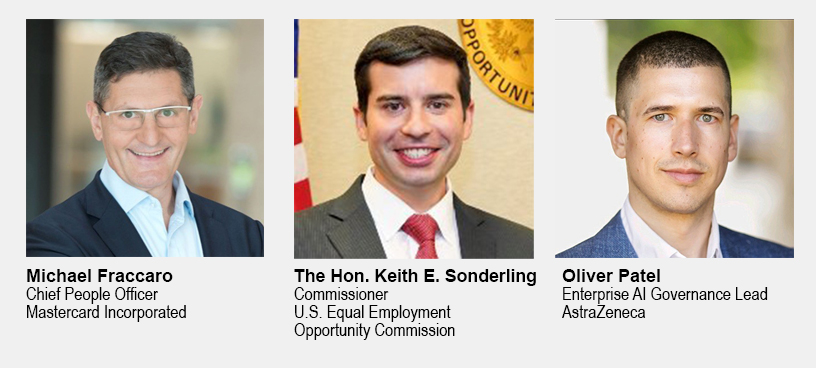
Europe takes the lead. Mr. Patel provided an overview of the recently passed EU AI Act, which is the world’s first comprehensive law regulating the use of AI. Mr. Patel emphasized that the law was horizontal, encompassing the full spectrum of AI use cases, in contrast to some recent U.S. laws which have been more vertically tied to specific use cases. While certain uses are prohibited, most are classified according to risk with different requirements for each.
“Absolute chaos.” Mr. Sonderling discussed the incoming onslaught of AI regulations and laws within the U.S. and across the world, with a variety of different regulators taking different approaches. Mr. Sonderling emphasized that despite the different use cases, at the end of the day, it is the employment decisions that will matter (at least under U.S. law) – and thus current employment and labor laws can and will still apply.
What happens when the dust settles? All the panelists stressed the uncertainty associated with overregulating AI when its uses are still in the process of being developed. “By regulating all of these use cases now, it is very difficult to know what the unintended consequences will be,” said Mr. Patel.
“You can’t prevent yourself from taking the plunge.” Mr. Fraccaro emphasized the importance of moving forward with AI adoption regardless of where the law is going. Mr. Fraccaro also discussed how organizations need to bring all teams together to make it work including HR, legal, and business partners.
Concurrent Session 3: How CHROs Can Reinvent Work and Unlock Innovation with Gen AI
By Megan Wolf
Ellyn Shook of Accenture and Alan May of Hewlett-Packard Enterprise discussed the framework CHROs should use in assessing AI and its adoption across the organization and showcased how a client used AI to improve the performance for their sales function.
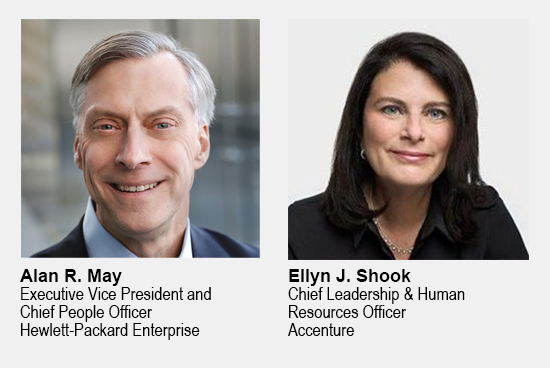
“If you use Gen AI to its fullest capability, you will reinvent your company,” Ms. Shook remarked as she described five C-suite imperatives:
- Lead with value;
- Understand and develop an AI enabled digital core;
- Reinvent talent and ways of working;
- Close the gap on responsible AI; and
- Drive continuous reinvention.
A pivotal moment. CHROs can reinvent work, reshape the workforce, and prepare workers for transformation by reflecting on AI first from an enterprise level, then from a workforce perspective and finally as an HR function.
Think broad and deep with enterprise-wide leadership. Think like a CEO. Establish and communicate ethical practices for AI. Mr. May suggested reviewing existing AI principles and customizing them to build an organization specific strategy.
Build AI literacy across the organization by digging deep to understand the data sources that will feed AI and identify the highest leverage use cases for the business. Mr. May reiterated the importance of this area stating, “What’s different about AI is that it is a living data set that will continue to be scraped and get smarter and smarter. It will learn more quickly than people can. You have to be custodians of your own data sets.”
Ms. Shook stated the importance of “involving people in the process early to build trust.” Fear often arises when current processes are not documented so involve employees in documenting the current process before rethinking processes with the application of Gen AI.
Find opportunities within the HR function. Focus on the ROI and what will enhance the HR experience. Use this as an opportunity to upskill the team, clean up data and challenge suppliers.
Use AI to assess future relevant skills. Mr. May encouraged everyone to focus on tasks and not jobs. He indicated, “It is table stakes now to understand the current skills of employees and reaggregate them.” This becomes the basis for upskilling and helps organizations re-architect roles and tasks.
Concurrent Session 4: How Do I Plan for the Future Impact on the Workforce?
By Ross Neely
HR Policy’s Chatrane Birbal led a discussion alongside Christopher J. Fernandez of Microsoft Corporation and Po-Shen Loh, Ph.D. of Carnegie Mellon University, on the rapidly changing workforce landscape created by AI and how companies can prepare to integrate the burgeoning applications of AI into the workplace.
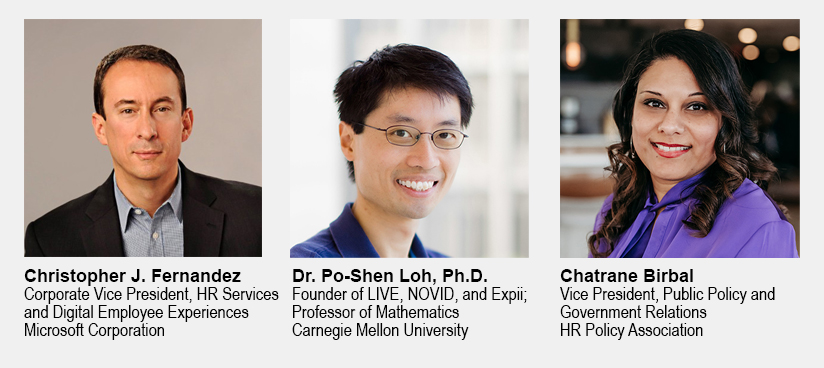
“CHROs play a critical role in evaluating the workforce impacts of AI usage and integration,” stated Mr. Fernandez while discussing job displacement and skill gaps. He discussed Microsoft's tech-labor partnership with the AFL-CIO which emphasizes transparency and collaboration in addressing the future of work, including sharing AI trends and incorporating worker perspectives. In addition, Microsoft’s collaborations with educational institutions aim to address skill requirements. The business community must continue to be proactive in addressing workforce concerns related to AI, utilizing metrics to measure the success of initiatives, and fostering a culture of continuous adaptation.
“Organizations must prioritize skills development and employee satisfaction” when navigating the changing landscape related to workforce dynamics in the age of AI, Mr. Fernandez counseled. This entails fostering a culture of learning, curiosity, and adaptability, while promoting responsible AI use through transparent decision-making processes.
For CHROs, “engaging employees who work with AI requires open communication, training programs, and opportunities for collaboration with your workforce” stated Po-Shen Loh. Drawing on his educational experience, he further stated that promoting continuous learning becomes crucial for organizations to remain competitive and relevant amidst rapid technological advancements. Looking ahead, CHROs should anticipate ongoing changes in workforce development, strategizing to stay ahead by embracing innovative training methods, fostering inclusivity, and aligning workforce strategies with emerging AI trends.
CHROs will continue to play a critical role in an organization’s integration with AI, by prioritizing skills development, and employee satisfaction, while also addressing the need for continuous training and learning opportunities.
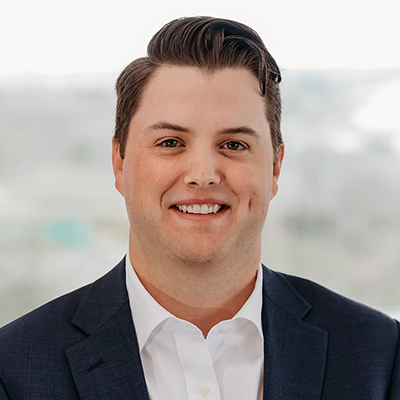
Gregory Hoff
Assistant General Counsel, Director of Labor & Employment Law and Policy, HR Policy Association
Contact Gregory Hoff LinkedIn